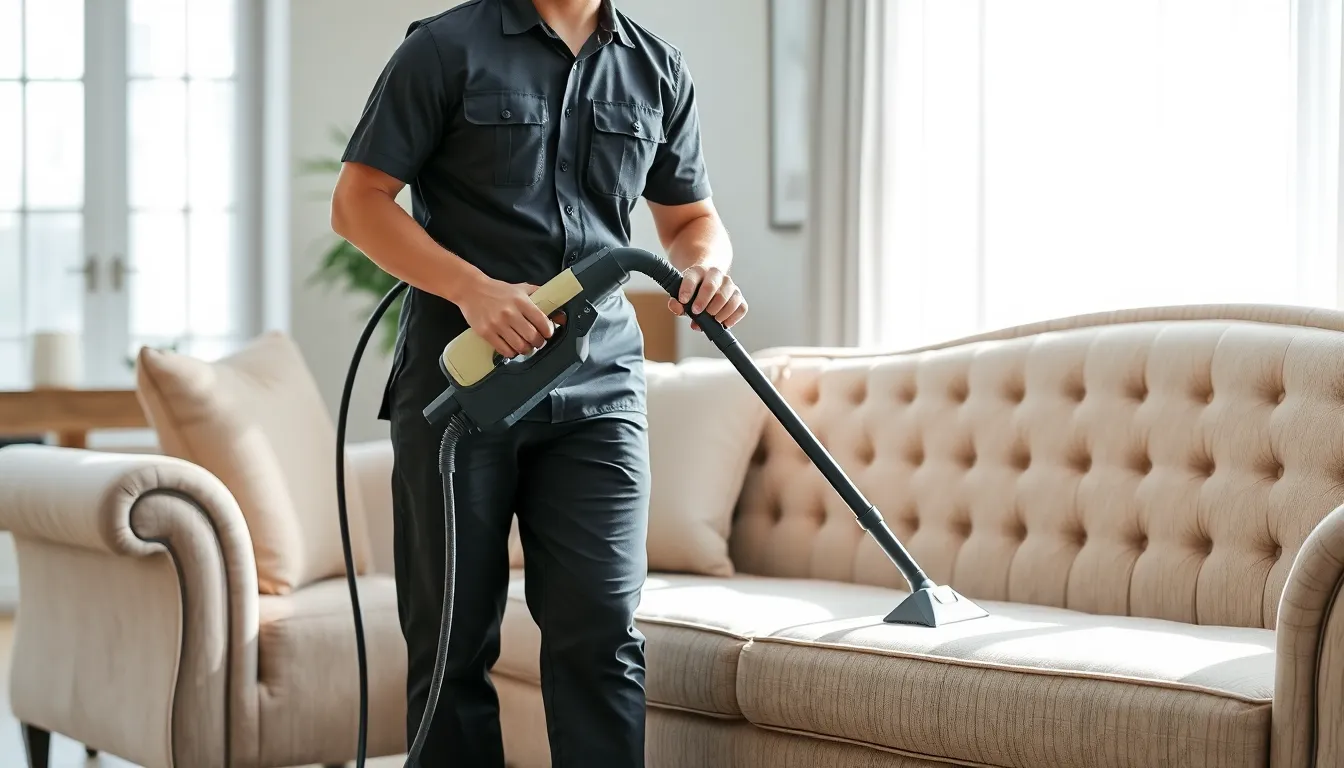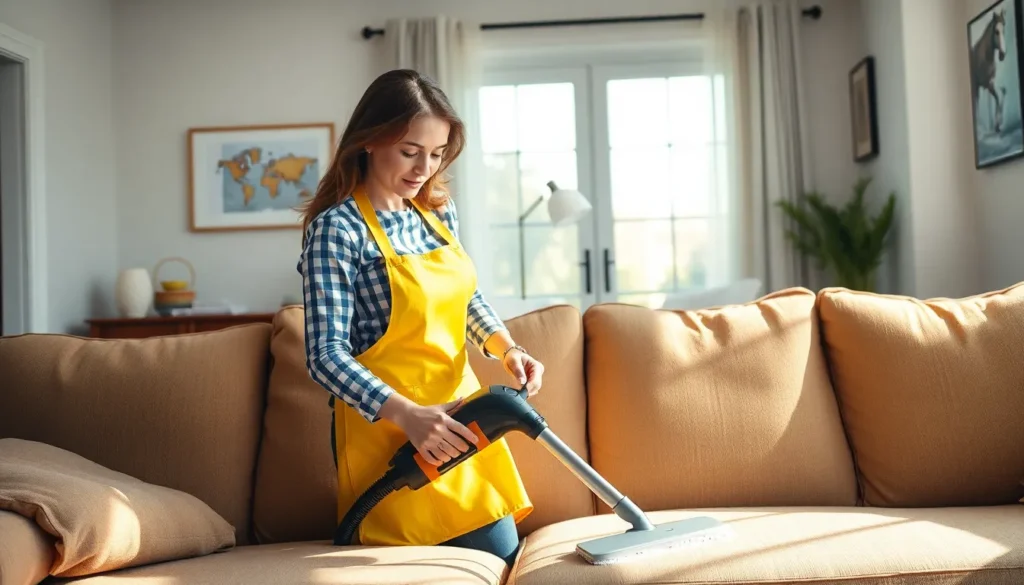Upholstery cleaning is often overlooked, yet it plays a crucial role in maintaining a healthy and inviting home. Over time, furniture collects dust, allergens, and stains that not only affect its appearance but also compromise indoor air quality. Regular cleaning can breathe new life into tired upholstery, enhancing both comfort and aesthetics.
Understanding the importance of upholstery care can save homeowners from costly replacements and health issues. Whether it’s a beloved couch or a cherished armchair, knowing how to effectively clean and maintain upholstery ensures longevity and keeps living spaces looking their best. Dive into the world of upholstery cleaning and discover tips and techniques that can transform your furniture and elevate your home’s atmosphere.
Table of Contents
ToggleWhat Is Upholstery Cleaning?
Upholstery cleaning involves the process of removing dirt, stains, and allergens from furniture fabrics. This type of cleaning uses specialized techniques and equipment designed to deep clean various materials, including microfiber, leather, and cotton.
Upholstery cleaning helps restore the original look of furniture while enhancing its lifespan. Professional cleaners utilize methods like steam cleaning, solvent cleaning, and dry cleaning to effectively treat stains and eliminate bacteria.
Regular upholstery cleaning maintains indoor air quality by reducing dust and allergens. It’s crucial for households with pets or allergy sufferers, as furniture tends to trap contaminants over time. Homeowners can opt for professional services or implement DIY methods for routine maintenance.
Benefits of Upholstery Cleaning

Upholstery cleaning offers several advantages that enhance both furniture lifespan and home ambiance. The importance of maintaining clean upholstery cannot be overstated, as it contributes significantly to health and aesthetics.
Improved Aesthetics
Improved aesthetics result from regular upholstery cleaning. Clean furniture looks fresher and more inviting, positively influencing the overall ambiance of a room. Stains, dirt, and allergens detract from visual appeal, making spaces feel neglected. Professional cleaning methods, such as steam cleaning and dry cleaning, restore the fabric’s original color and texture, enhancing the appearance of sofas, chairs, and cushions. An attractive, well-maintained living space leaves a lasting impression on guests and residents.
Extended Furniture Life
Extended furniture life occurs when upholstery cleaning becomes part of routine maintenance. Dirt and grime can wear down fabric fibers, leading to premature aging and the need for costly replacements. Regular cleaning removes abrasive particles that cause damage over time. Implementing professional cleaning services can significantly prolong the lifespan of upholstery, preserving its structural integrity and beauty. Maintaining clean furniture not only saves money on replacements but also contributes to a more sustainable household.
Methods of Upholstery Cleaning
Upholstery cleaning methods vary based on fabric types and the level of cleaning required. Two primary methods include steam cleaning and dry cleaning, each with distinct advantages for furniture care.
Steam Cleaning
Steam cleaning utilizes hot water vapor to penetrate fabric fibers, effectively loosening dirt, allergens, and stains. The process begins with vacuuming the upholstery to remove loose debris. Technicians then apply steam using specialized machines, which can reach temperatures of up to 200°F. This high heat not only cleans but also sanitizes the fabric by eliminating harmful bacteria and dust mites. Following the steam application, a vacuum extracts excess moisture, ensuring the upholstery dries quickly, typically within a few hours. Steam cleaning is particularly effective on synthetic fabrics and can rejuvenate colors while removing tough stains.
Dry Cleaning
Dry cleaning employs a chemical solvent to clean upholstery without using water. First, technicians assess the fabric to determine compatibility with the dry cleaning solution. Next, they apply the solvent using a soft brush or cloth, gently agitating the fabric to lift dirt and stains. After a set dwell time, a vacuum removes residue and contaminants, leaving the upholstery clean and dry. This method is suitable for delicate fabrics that might shrink or distort with water. Dry cleaning also minimizes moisture exposure, reducing the risk of mold and mildew growth in humid environments.
DIY Upholstery Cleaning Tips
These tips offer practical guidance for homeowners interested in cleaning their upholstery effectively. Successful DIY cleaning involves using appropriate materials and following a structured process.
Materials and Ingredients
- Baking Soda: Absorbs odors and freshens fabric fibers.
- White Vinegar: Acts as a natural disinfectant and stain remover.
- Liquid Dish Soap: Works well for breaking down grease and stains.
- Spray Bottle: Useful for applying cleaning solutions evenly.
- Soft Brush or Cloth: Helps in scrubbing fabric without causing damage.
- Vacuum Cleaner: Efficient for removing loose dirt and debris before cleaning.
Step-by-Step Process
- Vacuum Upholstery: Remove dirt and dust using a vacuum cleaner with an upholstery attachment.
- Prepare Cleaning Solution: Mix one cup of white vinegar, two cups of water, and one tablespoon of liquid dish soap in a spray bottle.
- Test Fabric: Apply the cleaning solution to a hidden area of the upholstery to check for color fastness.
- Apply Solution: Lightly mist the cleaning solution across the stained area, avoiding oversaturation.
- Gently Scrub: Using a soft brush or cloth, gently scrub the fabric in circular motions to lift stains.
- Rinse Cloth: Wipe the area with a damp cloth to remove cleaning solution residue.
- Dry the Fabric: Allow the upholstery to air dry completely to prevent mildew.
- Sprinkle Baking Soda: After drying, sprinkle baking soda to absorb residual odors and vacuum once more.
Professional Upholstery Cleaning Services
Professional upholstery cleaning services deliver specialized expertise and equipment, ensuring thorough cleaning and care for various types of furniture fabrics. Homeowners often rely on these services to maintain the quality and longevity of their upholstery.
What to Look For in a Service
When selecting a professional upholstery cleaning service, consider the following factors:
- Experience: Choose a service with years of industry expertise, as seasoned professionals understand different fabrics and cleaning techniques.
- Certification: Opt for companies accredited by organizations like the Institute of Inspection, Cleaning and Restoration Certification (IICRC), indicating a commitment to quality.
- Customer Reviews: Assess online reviews and testimonials to gauge customer satisfaction and service reliability.
- Methods Used: Inquire about cleaning methods employed. Look for services that provide eco-friendly options and use advanced techniques like steam cleaning and low-moisture cleaning.
- Insurance: Confirm that the service carries liability insurance to protect against potential damages during the cleaning process.
- Guarantees: Seek services that offer satisfaction guarantees, ensuring they’ll re-clean or address issues if customers are unsatisfied.
Cost Considerations
Cost factors vary widely based on services offered and the specifics of the upholstery:
| Service Type | Estimated Cost per Upholstery Item | Factors Influencing Price |
|---|---|---|
| Sofa Cleaning | $100 – $250 | Size, fabric type, and condition |
| Chair Cleaning | $50 – $150 | Type of chair and fabric complexity |
| Stain Removal | $25 – $75 per stain | Difficulty of stain and cleaning method |
| Fabric Protection | $15 – $40 per item | Type of treatment and size of upholstery |
Expect additional costs for specialized services, such as stain removal or fabric protection. Requesting estimates from multiple providers helps compare rates and find the best value.
Upholstery cleaning plays a vital role in creating a healthy and inviting living space. By addressing dust allergens and stains, homeowners can significantly enhance both the appearance and air quality of their homes. Whether opting for professional services or adopting DIY methods, regular maintenance is essential for prolonging the life of furniture.
Investing time and effort into upholstery care not only improves aesthetics but also contributes to a more sustainable household. With the right techniques and knowledge, homeowners can ensure their furniture remains a beautiful and functional part of their decor for years to come.



